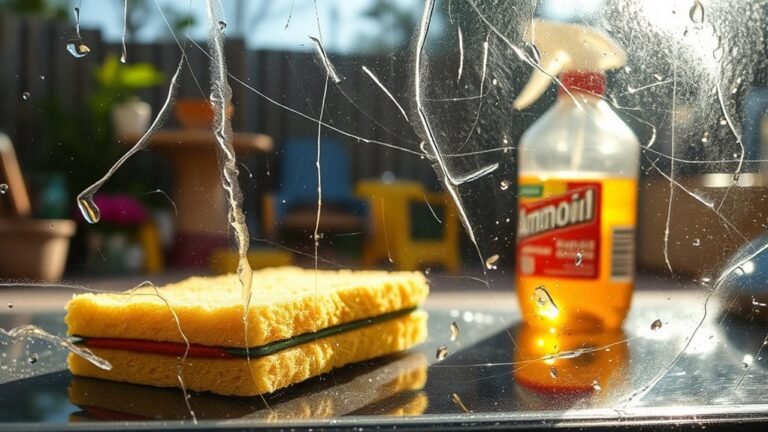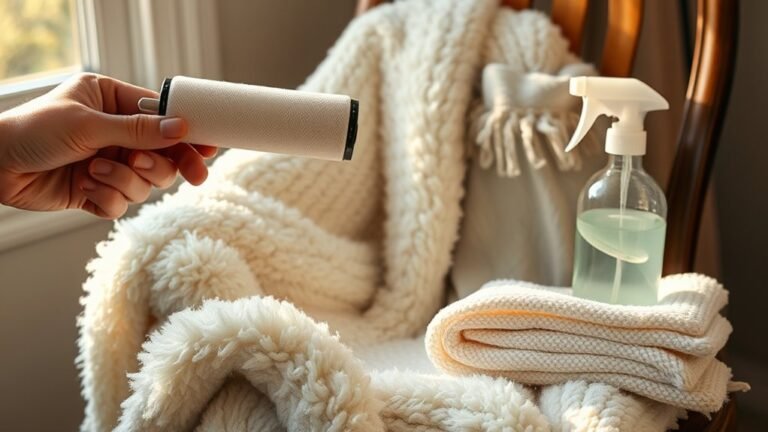DIY Cleaner for Laminate
You can make an effective DIY laminate cleaner with simple ingredients like vinegar, water, and a few drops of mild dish soap. Mix two parts water to one part vinegar in a spray bottle, add soap, and shake gently. This cleaner removes dirt without harsh chemicals, protecting your laminate surfaces. Use a soft cloth to avoid scratches and never soak the floor. Want to know how to customize your cleaner and maintain your laminate for lasting shine?
Benefits of Using a Homemade Laminate Cleaner

While commercial cleaners might seem convenient, using a homemade laminate cleaner offers several distinct benefits that you’ll appreciate. First, it’s a cost effective solution—you can make a batch with simple household ingredients, saving you money over time. You’re in control of what goes into your cleaner, avoiding harsh chemicals that can damage your laminate or harm your health. Plus, it’s an eco friendly alternative, reducing plastic waste from store-bought bottles and minimizing your environmental footprint. Homemade cleaners work efficiently to remove dirt and grime without leaving residue, maintaining your laminate’s finish. This approach gives you the freedom to tailor your cleaner to your needs while protecting your home and the planet responsibly. It’s practical, safe, and liberating all at once.
Essential Ingredients for Your DIY Laminate Cleaner
Because laminate surfaces require gentle yet effective cleaning, choosing the right ingredients for your DIY cleaner is vital. Start with a vinegar solution—a blend of white vinegar and water—that naturally cuts grease and disinfects without damaging the laminate’s finish. It’s powerful yet mild enough to preserve your surface’s integrity. Baking soda is another important ingredient; its mild abrasiveness tackles stubborn stains and neutralizes odors without scratching. Together, these two ingredients form a balanced, eco-friendly base. You can customize this foundation with a few drops of essential oils for freshness or a small amount of gentle liquid soap to boost cleaning power. By selecting these essentials, you maintain your laminate’s beauty and extend its life, all while keeping your cleaning routine simple, safe, and effective.
Step-by-Step Guide to Making Your Cleaner

To make your DIY laminate cleaner, gather just a few simple ingredients and tools you likely already have at home. Start by measuring your ingredients carefully to maintain proper ingredient ratios, essential for effective cleaning techniques without damaging your laminate. Mix these in a spray bottle for easy application.
| Step | Action | Tip |
|---|---|---|
| 1 | Combine water & vinegar | Use 2:1 ratio for safety |
| 2 | Add a few drops of soap | Mild dish soap preferred |
| 3 | Shake gently before use | Avoid harsh scrubbing |
Following this guide guarantees your cleaner is potent yet gentle, giving you freedom to maintain pristine laminate surfaces confidently.
Tips for Safely Cleaning Laminate Surfaces
When you clean laminate surfaces, it’s important to use gentle techniques that protect the material’s finish and prevent warping or discoloration. Start by using a soft cloth or microfiber mop to avoid scratches. Avoid soaking the surface—excess water can seep into seams, causing damage. Always opt for safe cleaning solutions, like your DIY cleaner, that won’t strip the laminate protection layer. Steer clear of harsh chemicals, abrasive pads, or steam cleaners, as they can dull or damage the finish. Wipe spills promptly to prevent staining or swelling. By following these practical tips, you maintain the durability and appearance of your laminate surfaces, allowing you the freedom to enjoy a clean, attractive space without risking costly repairs or replacements.
How to Maintain Laminate Floors and Countertops

Keeping your laminate surfaces looking great goes beyond just cleaning them gently. To maintain both floors and countertops, adopt specific cleaning techniques that protect the finish and extend their lifespan. Use a soft mop or cloth dampened with a DIY cleaner to avoid scratching. Avoid excessive water—laminate is sensitive to moisture, which can cause warping or swelling. For countertops, promptly wipe spills to prevent stains and use cutting boards to avoid scratches. Regularly dust floors to remove abrasive dirt particles. Laminate care also means steering clear of harsh chemicals or abrasive tools that degrade the surface. By committing to these practical steps, you preserve your laminate’s durability and appearance, giving you freedom from frequent repairs and replacements while enjoying a fresh, polished look.
Frequently Asked Questions
Can DIY Laminate Cleaner Remove Tough Stains Like Ink or Paint?
You might find that DIY laminate cleaner can tackle some tough stains, but ink removal techniques often require specific ingredients like rubbing alcohol or vinegar to break down the pigment effectively. For paint stain solutions, gently scraping off excess paint before applying a mild solvent usually works best. Remember, testing a small area first is key to avoid damage. With the right approach, you can confidently restore your laminate’s look without harsh chemicals.
How Often Should I Use Homemade Cleaner on Laminate Surfaces?
Think of your laminate surfaces like a garden that needs regular watering—too much or too little can cause harm. For ideal surface maintenance, aim for a cleaning frequency of once a week with your homemade cleaner. This keeps dirt and grime at bay without wearing down the finish. If you have spills or sticky spots, don’t hesitate to clean them immediately. This balanced routine guarantees your laminate stays fresh while giving you the freedom to enjoy your space.
Is Vinegar Safe to Use on All Types of Laminate?
You might wonder if vinegar is safe for all types of laminate. While vinegar benefits your cleaning routine by cutting grease and disinfecting, it’s acidic and can damage some laminate finishes over time. For laminate care, it’s best to dilute vinegar with water and test a small area first. If you want to keep your surfaces looking great and avoid wear, consider gentler alternatives or use vinegar sparingly.
Can I Store Homemade Cleaner for Long Periods?
Think of your homemade cleaner as a delicate garden—without proper care, it won’t flourish. For best results, store it in a cool, dark place to extend its lifespan. Use airtight containers to keep it fresh and prevent contamination. Avoid keeping it for more than a month or two, as natural ingredients can lose effectiveness. With these storage tips, you’ll enjoy a reliable, ready-to-use cleaner whenever you need freedom from grime.
What Should I Avoid Mixing With DIY Laminate Cleaners?
You should avoid mixing bleach compounds or ammonia solutions with your DIY cleaners because combining them can create toxic fumes, which are dangerous to your health. Also, these harsh chemicals might damage the laminate’s surface, causing discoloration or warping. Stick to gentle ingredients like vinegar or mild soap to keep your floors safe and looking great—this way, you maintain freedom in your cleaning routine without risking harm or compromising your laminate’s finish.






